Open Source Chatbots: Features, Benefits, and Best Platforms
Open-source chatbots empower businesses to create customizable and cost-effective automated solutions. These tools transform customer engagement strategies. In this article, we examine their features, benefits, and top platforms.
What is an Open-Source Chatbot?
Open-source chatbots offer a revolutionary approach to conversational AI, providing businesses and developers with unmatched control and flexibility. At its core, an open-source chatbot is a conversational interface whose source code is freely available for anyone to view, modify, and distribute. This transparency sets open-source solutions apart from proprietary platforms, fostering innovation and collaboration within the developer community.
Interested in open-source stacks? Take a look at our selection of AI open-source tools.
The advantages of using open-source chatbots are compelling:
- Transparency: Users can scrutinize the codebase, ensuring security and reliability.
- Cost-effectiveness: They often come without licensing fees, making them attractive for businesses of all sizes.
- Customization: Developers can tailor the chatbot to specific needs, seamlessly adding features or integrating with existing systems.
- Community support: A vibrant ecosystem of developers contributes to ongoing improvements, bug fixes, and feature enhancements.
- Deploy-it where you want.
These benefits propel open-source chatbots into various applications across industries. Common use cases include:
- Customer service: Offering 24/7 support and efficiently handling routine inquiries.
- FAQs: Providing instant answers to frequently asked questions, reducing the load on human support teams.
- Lead generation: Engaging website visitors and capturing potential customer information.
The versatility of open-source chatbots goes beyond these examples. Businesses leverage this technology for improved customer engagement and operational efficiency.
Open-source chatbot platforms offer varying levels of customization, from no-code solutions like Typebot to code-heavy frameworks like Bottender. Consider your technical expertise when choosing a platform.
Popular Open-Source Chatbot Platforms
Typebot
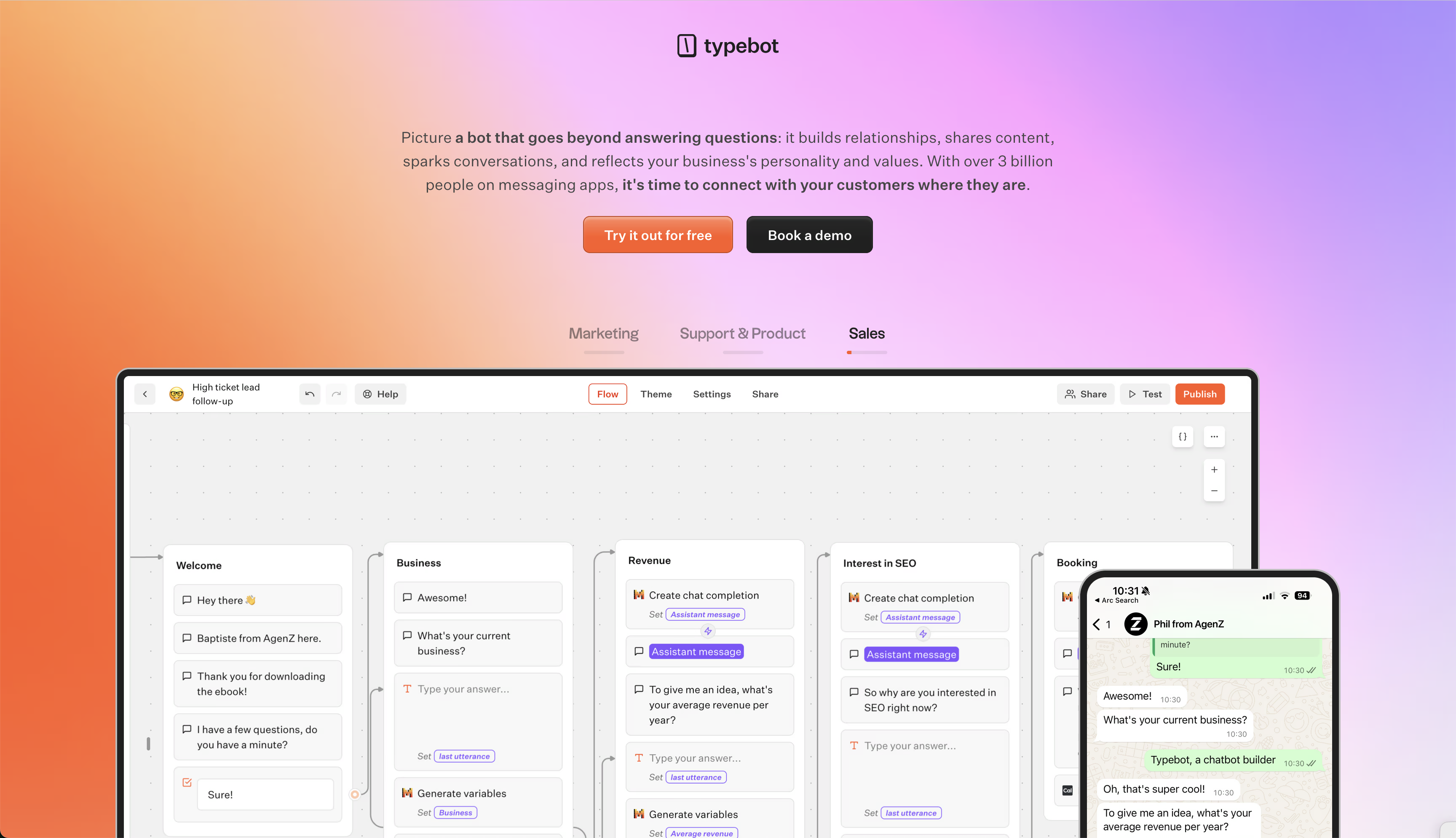
Typebot stands out as a versatile and user-friendly open-source chatbot platform. Its visual drag-and-drop interface simplifies the process of creating conversational forms and chatbots. This makes it accessible to users with varying levels of technical expertise.
Key features of Typebot include:
- Conversational Form Builder: Enables the creation of engaging, interactive forms that enhance user interaction and data collection.
- Integration Options: Supports seamless integration with external platforms such as OpenAI, Google Sheets, WhatsApp, and various other channels.
- Theming Options: Offers customization capabilities to match the chatbot's appearance with brand aesthetics.
- Advanced Functionalities: Includes features like computation, conditional branching, and team collaboration for complex form-building needs.
Typebot combines powerful features with ease of use. The intuitive design and extensive integration capabilities make it a compelling choice for businesses looking to enhance customer engagement and streamline data collection processes.
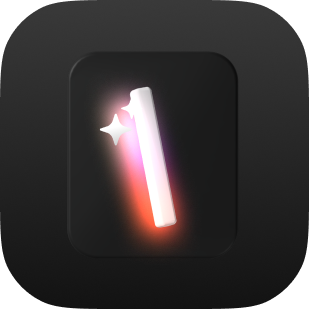
No trial. Generous free plan.
Botpress
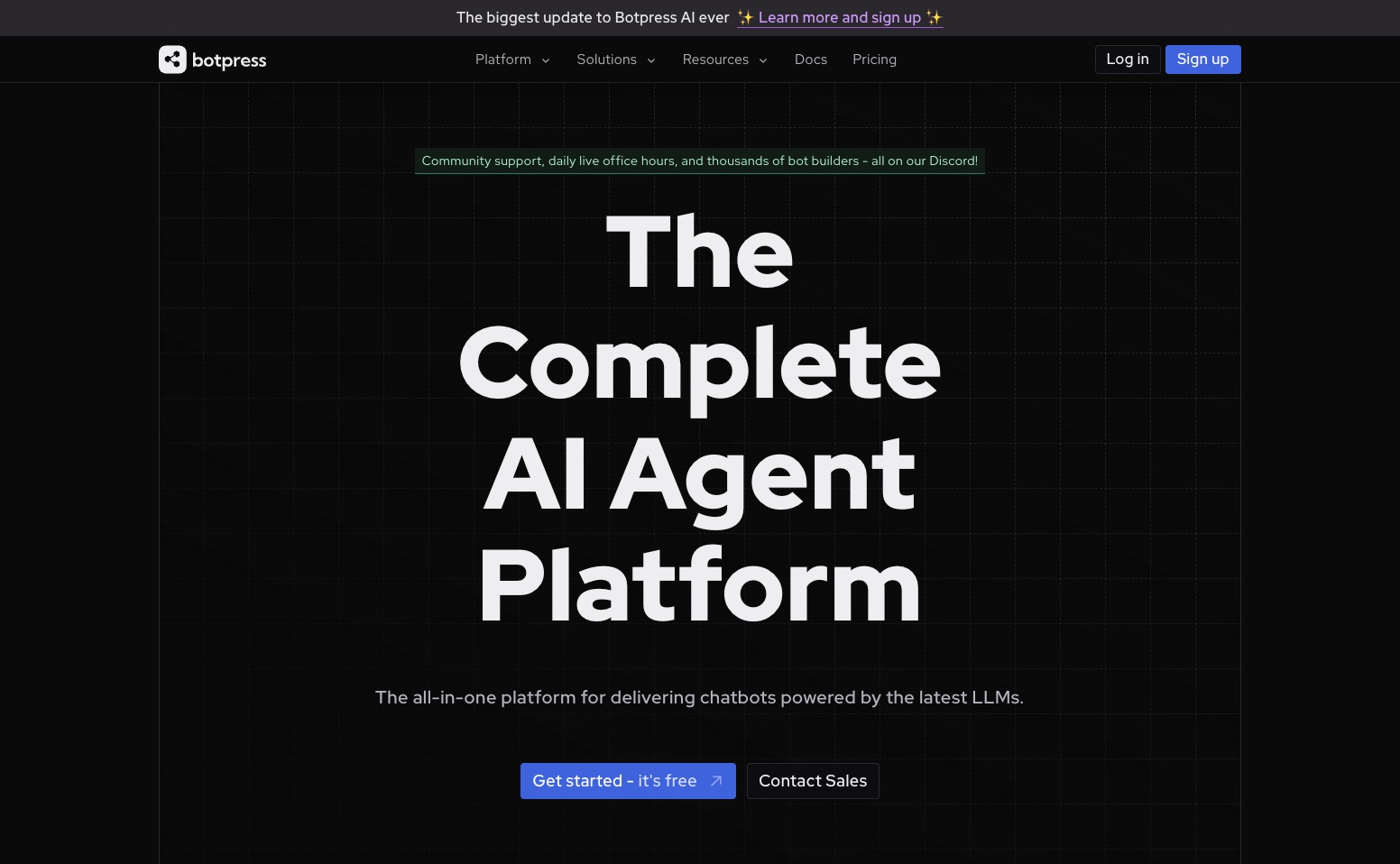
Botpress is a robust platform for creating AI-powered chatbots. It balances no-code options with advanced customization capabilities.
Key benefits of Botpress include:
- Visual Flow Builder: Create complex chat automations using a drag-and-drop interface.
- Built-in AI Capabilities: Features such as knowledge agents, personality agents, and sentiment analysis.
- Multi-channel Support: Allows deployment across various platforms including websites, Facebook, and WhatsApp.
However, Botpress has some limitations:
- Learning Curve: Mastering complex features may require time and effort.
- Technical Setup: Publishing on certain channels demands technical knowledge.
- Limited Marketing Features: The platform focuses more on customer support than marketing functionalities.
- Limited logic functionalities
Bottender
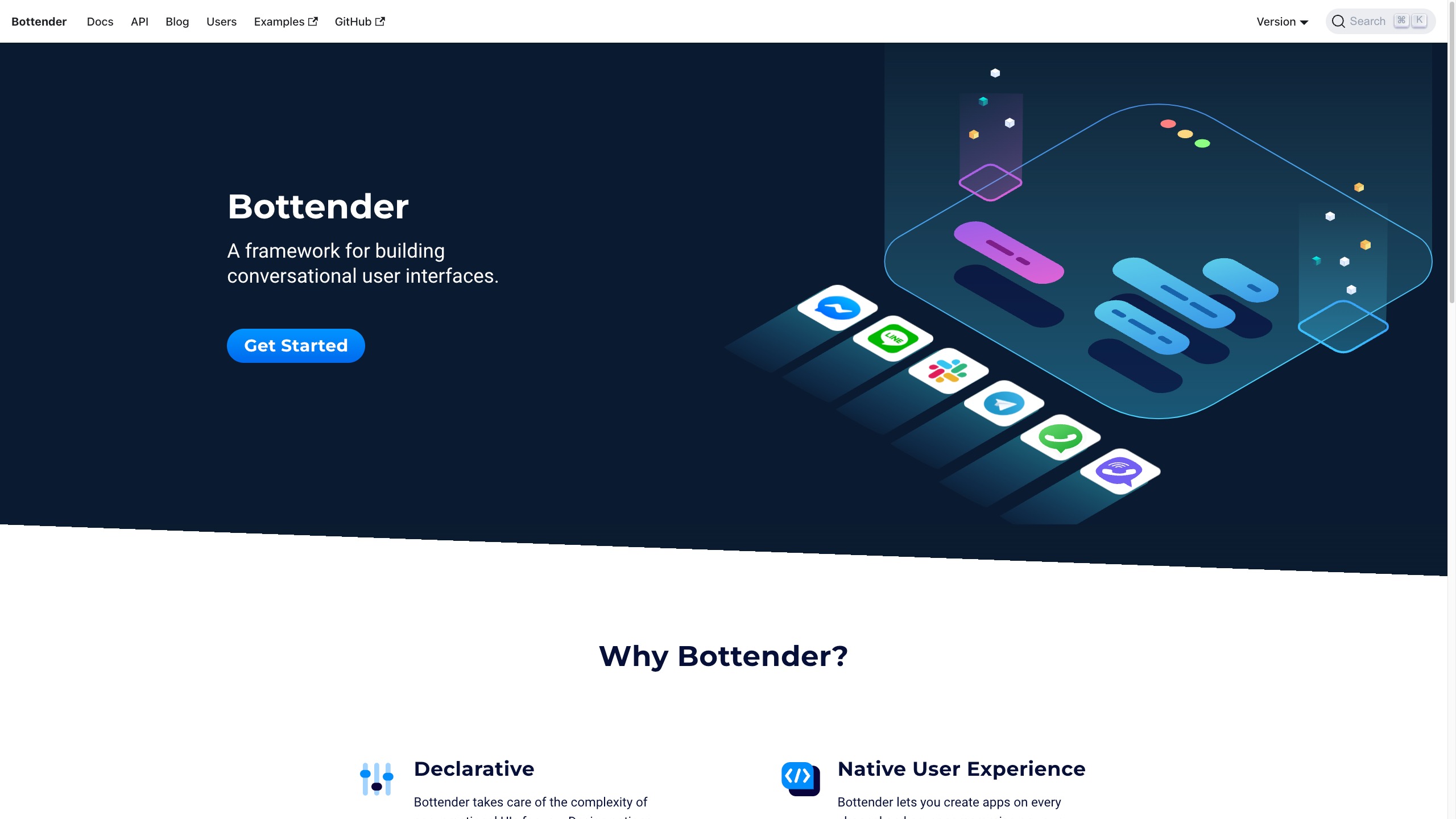
Bottender is a framework for building conversational user interfaces with a focus on real-world applications.
Key features include:
- Declarative Approach: Simplifies the design of actions for each event and state in the application.
- Multi-Channel Support: Compatible with platforms like Facebook Messenger, LINE, Slack, and Telegram.
- Built-in NLP: Integrates with natural language processing tools for enhanced conversational capabilities.
Limitations of Bottender:
- Limited API
- No cloud version available
- No built-in integrations with tools like Google Sheets or Zapier
- Requires coding skills to define bot behavior
Bot Libre
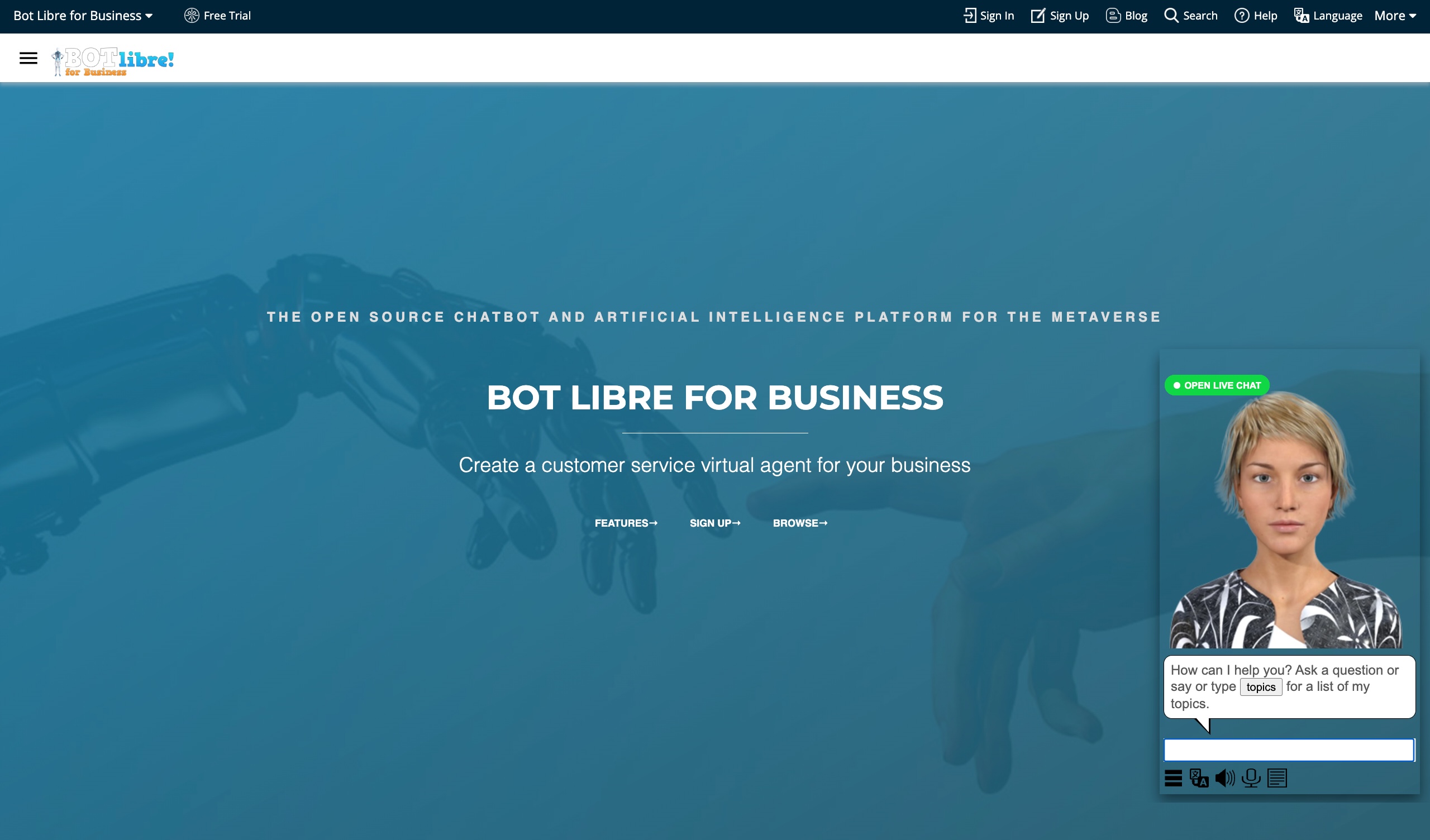
Bot Libre offers a comprehensive suite of tools for creating and managing chatbots and AI solutions.
Key features include:
- Bot Creation: An easy-to-use interface with options to choose from bot templates or fork existing bots.
- Avatars: Design 3D animated avatars and embed them on websites.
- Social Media Integration: Supports connection with multiple social media platforms.
Limitations of Bot Libre:
- No cloud version
- Limited chat input options
- User interface may not be as intuitive as some competitors
- Lack of built-in integrations with popular tools
OpenAssistantGPT
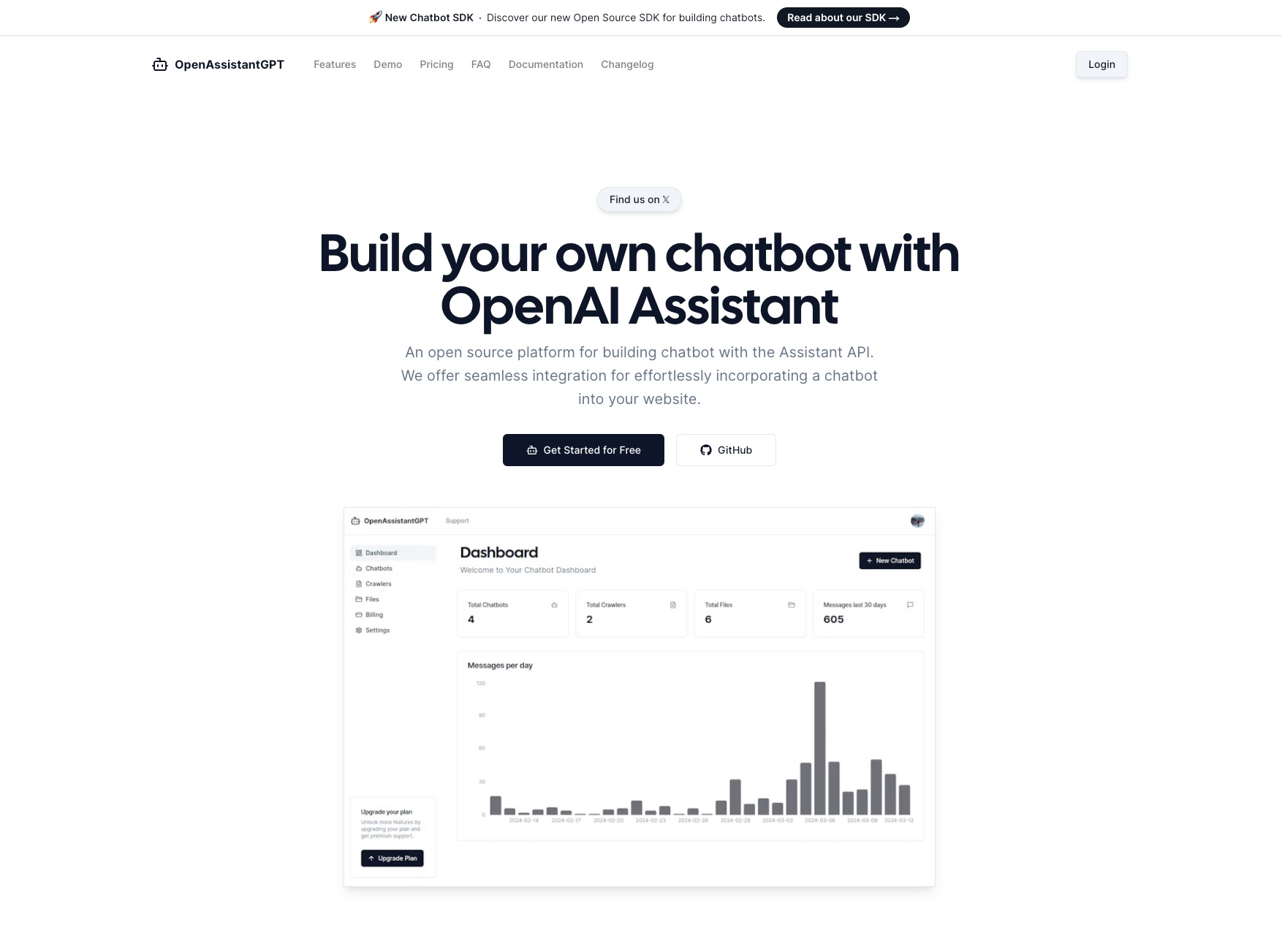
OpenAssistantGPT leverages OpenAI's powerful language models to create advanced chatbots.
Key benefits include:
- Integration with OpenAI's Assistant API: Utilizes GPT-4 and GPT-3.5 models for sophisticated conversational capabilities.
- Easy Website Integration: Designed for seamless integration using JavaScript.
- Cost-Effective: An affordable solution for implementing advanced chatbots.
Limitations of OpenAssistantGPT:
- Dependence on OpenAI API: Requires an OpenAI API key, which may involve additional costs.
- Limited to LLM compatibility
- Restricted chat features: lacks support for images and GIFs
- Limited input types and logic options
- No built-in integrations with tools like Google Sheets or Zapier
How to Choose the Best Open-Source Chatbot Software for Your Needs
Selecting the right open-source chatbot platform is crucial for the success of your project.
Check also our selection of the best chatbot for Wordpress
Here's a guide to help you make an informed decision:
Identifying Business Requirements
The first step is to clearly define your business requirements. Consider the primary use case for your open-source chatbot—whether it's customer service, lead generation, or internal operations. Determine the level of complexity required, such as advanced natural language processing, multi-channel support, or integration with existing systems.
Evaluating Key Features
Compare the features of each platform against your requirements:
-
User Interface: If ease of use is paramount, Typebot's visual drag-and-drop interface might be ideal.
-
Integration Capabilities: Consider platforms like Typebot or Botpress if you need extensive integration options.
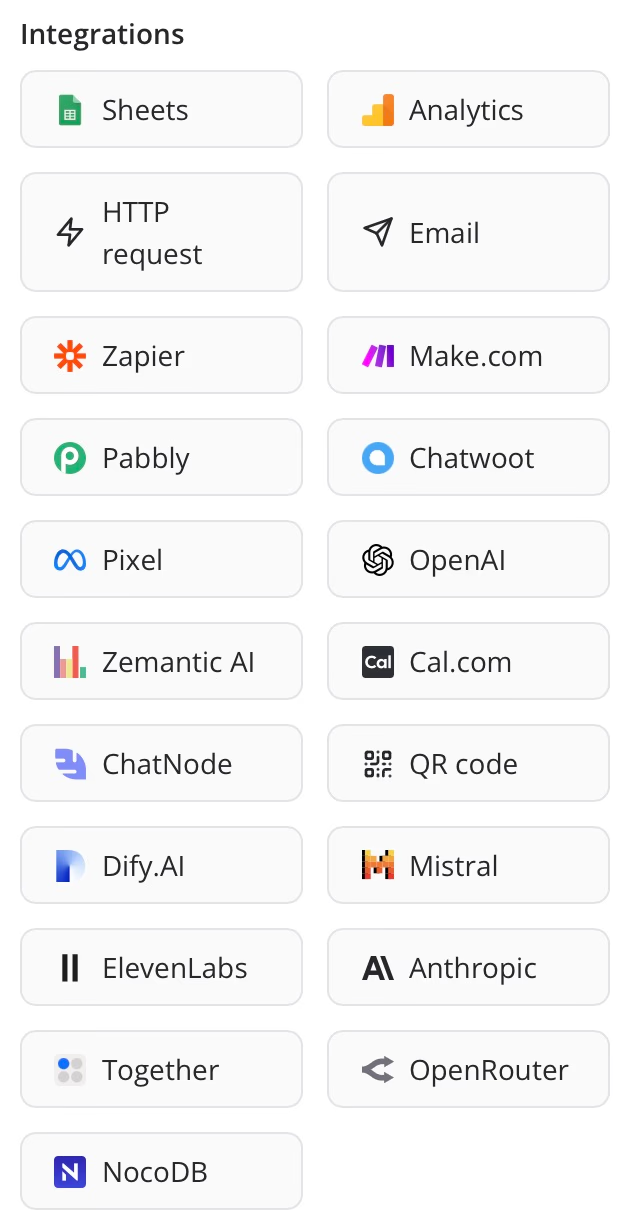
Typebot's available integrations -
Customization: For deep customization, Bottender's declarative approach might be suitable, though it requires coding skills.
-
Scalability: Evaluate how each platform handles increased load and complexity.
-
Maintenance: check if the repo is updated on a regular basis. Check the number of issues, how long they have been non resolved, etc.
Community and Support Considerations
The strength of an open-source project often lies in its community. Assess the quality of a chatbot's community by:
- Checking the project's GitHub repository for activity levels, number of contributors, and frequency of updates.
- Exploring community forums or Discord channels to gauge user engagement and support.
- Looking for comprehensive documentation, tutorials, and examples.
A vibrant community, like the one supporting Typebot, can be invaluable for troubleshooting and ongoing development.
Customization and Scalability
Consider your long-term needs:
- Will you need to extensively modify the chatbot's functionality?
- How much traffic do you expect the chatbot to handle?
- Do you anticipate expanding to multiple channels or platforms?
Platforms like Typebot and Botpress offer a good balance of customization options and scalability.
For more details, check our article on how to build a chatbot using React.
Real-World Examples and Case Studies
Examine case studies or success stories from businesses similar to yours. A customer service team might find value in Bot Libre's live chat features, while a marketing team might prefer Typebot's lead generation capabilities.
Measuring Chatbot Success
To evaluate the effectiveness of your chosen open-source chatbot framework, consider these metrics:
- User Engagement: Measure conversation length and completion rates.
- Task Completion Rate: Track how often the chatbot resolves queries without human intervention.
- Customer Satisfaction: Use post-conversation surveys to gauge user satisfaction.
- Response Time: Monitor how quickly the chatbot responds to user inputs.
- Conversion Rates: For lead generation chatbots, track how many conversations lead to desired actions.
By evaluating these aspects, you can choose an open-source chatbot platform that aligns with your business goals and technical requirements. The best choice depends on your specific needs, resources, and long-term objectives.
Getting Started with Typebot
Typebot offers a user-friendly approach to building chatbots. Here's a step-by-step guide to help you create your first chatbot using this platform:
Step-by-Step Guide to Building Your First Chatbot
- Sign up for a Typebot account on their website.
- Create a new project and choose a template or start from scratch.
- Use the drag-and-drop interface to add text, input fields, and buttons.
- Connect these blocks to create a logical flow for your conversation.
- Customize the appearance using the theming options to match your brand.
- Test your chatbot using the preview feature.
- Publish and embed the chatbot on your website or chosen platform.
Advanced Customization Techniques
Typebot allows for advanced customization through:
- Custom CSS: Modify the chatbot's appearance beyond built-in theming options.
- JavaScript Code: Add custom functionality or integrate with external services.
- Variables: transfer data from the webpage to the chatbot.
- Webhooks: Connect your chatbot to external APIs for enhanced capabilities.
- Train your chatbot on your own data
Open-source chatbots have revolutionized customer engagement, offering businesses powerful tools to enhance communication strategies. From Typebot's user-friendly interface to Botpress's AI capabilities, each platform presents unique strengths.
As you start your chatbot journey, remember that success lies not just in choosing the right platform, but in crafting conversations that resonate with your audience.

No trial. Generous free plan.